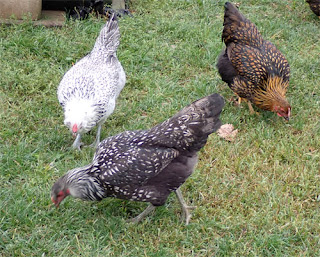Almost the very instant that I posted that the pullets had not escaped from the run, Spot and Silvia were out on a Big Adventure. Terry found them in the grapes, quite a distance from the run. I would have thought they’d go back to the apple orchard. They proved me wrong. Terry was able to get them back into the run by himself. In a flash of brilliance, he threw some scratch grains in the far side of the run when he left the gate open. The rest of the chickens concentrated on eating scratch grains and did not notice that they could run free. He herded Spot and Silvia toward the gate, and in they went.
Terry felt that I should clip the wings of all the pullets on the assumption that if some of them were still small enough to fly, they probably all were. I, on the other hand, preferred to take the “innocent until proven guilty” approach and clipped only Spot and Silvia. Wing clipping is no worse than cutting a fingernail. There is no pain. Only one wing gets clipped, which renders the bird unbalanced and (in theory) unable to fly. I will admit that it has not always worked. In this case, however, Spot and Silvia appeared chagrined the next day, and neither has escaped since.
 |
| Silvia and Spot trying to look innocent with one of the Wyandottes |
I don’t like to clip wings if I don’t have to because it detracts from the chicken’s appearance. I always clip their right side because I hold them under my left arm. My arm pins down the left wing, and I can use my left hand to pull out the right wing to be clipped by my right hand.
 |
| Spot's unclipped side |
 |
| Spot's clipped side. |
The Wyandottes were showing off their flight skills today, but stayed in the run. They still get to keep their wing feathers.
 |
| Two Wyandottes teetering on the shade shelter. They miss the apple trees. |
My harvest is nearly finished. I still have to roast, skin, and deseed peppers for freezing. I will do poblanos and bell. The jalapeños will just be roasted. It took forever for the bell peppers to turn red. Even now, there’s only two. We are supposed to see temps in the 80s again this weekend, which may motivate them to get on it.
 |
| One of two red bell peppers |
I already pulled two of my zucchini plants that were succumbing to stem borer. I will pull the rest when I get a moment. One of they is getting weird tumors on the fruits. I don’t know what causes these malformations, but I am hesitant to eat them. It’s probably completely harmless. Still, it isn’t appetizing.
 |
| Two tumerous zucchini |
In a cruel twist of fate, the Divino Brussels sprouts had poor germination, but the three survivors have nicely developing sprouts.
 |
| Divino Brussels sprouts |
The Long Island Brussels sprouts germinated well, but are currently doing squat in the sprout department. I’m hoping they will start Brusseling in the cool weather. If it doesn’t get too cold too soon, we might get sprouts that are larger than marbles.
 |
| Weenie Long Island Brussels sprouts |
Terry’s harvest is ramping up now. The pumpkin vines are dying back. One of them is still blooming bravely. I was impressed with the size of this flower. It was probably 6 inches across. It is doomed to die without having the fruit mature. It’s just too late in the season.
 |
| The last pumpkins in the garden plus one huge pumpkin flower |
Here’s the pumpkins and squash that Terry has picked.
 |
| Pumpkin and squash harvest |
We’ve been picking raspberries every other day.
 |
| The raspberries are better than expected, given the summer drought |
I made a raspberry pie Sunday to share with guests. I love raspberry pie.
 |
| Raspberry pie topped with whipped cream. Mmm. |
Terry has also started the apple harvest, which is not, praise be, as large as last year.
 |
| Apples |
I went out to look at my native plants today. The second spike of cardinal flowers is blooming. The spotted appearance is from water droplets.
 |
| More blooms on the cardinal flower |
The obedient plants are blooming.
 |
| Obedient plant |
These are supposed to be orange coneflowers. They look yellow to me. In any case, we can say for certain that they are not purple coneflowers, which was the other variety that came in the assortment.
 |
| Alleged "orange" coneflowers |
The pink milkweed had odd orange-yellow bumps on the seed pods and stems.
 |
| Orange bumps on pink milkweed |
Closer inspection showed the bumps to be aphids.
 |
| Aphid infestation |
At this
point in the season, I don’t think they can do much harm. The seeds will
probably mature. Aphids have the ability to produce an entire generation from
one female, who reproduces asexually. Under some conditions, sexual
reproduction occurs. Whenever I see aphids, I remember being in a store with Peg,
a plant pathologist. We saw a Noah’s Ark toy, complete with pairs of many animals.
Peg said, “You only need one aphid.”































